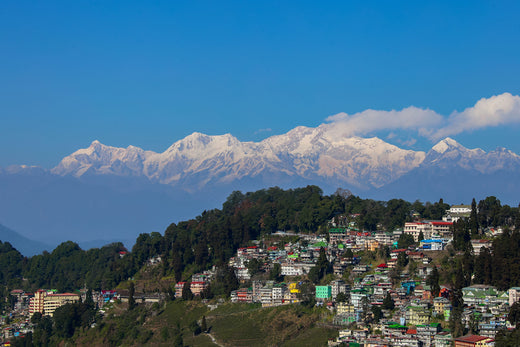Just like many aspects of life, the world of tea ranges from simple everyday pleasures to unimaginable luxuries. Tea is more than just a drink; it's an art form infused with ancient traditions and captivating stories that shape the essence of tea culture. Dive into a world where tea is celebrated as the epitome of sophistication and exclusivity. Discover the factors determining the price of exquisite tea leaves and the exceptionally refined varieties that captivate connoisseurs worldwide.
Journey into the Realm of Exquisite Tea Leaves
For centuries, tea has symbolized luxury and refined enjoyment. Globally, several renowned regions are famous for producing high-quality teas. Specifically, China, Japan, India, Taiwan, and Sri Lanka are known for their ideal climate conditions and masterful cultivation and processing techniques that produce world-class and highly prized teas.
Take, for example, the magnificent Wuyi Mountains in China, the birthplace of tea, and an iconic growing region known for its exquisite tea varieties. Since the Tang Dynasty (618-907 AD), teas of unparalleled quality have been produced in this picturesque region using time-honored methods and traditions. The historical significance of tea as a luxury item extends far beyond its mere enjoyment as a beverage; it was often used as a gift to forge political alliances and strengthen relationships!

What Makes a Tea Incredibly Expensive?
When does tea transform from a delightful indulgence into a sought-after luxury? This transformation occurs when extraordinary production methods come into play, emphasizing skilled handiwork and requiring extensive expertise. The more elaborate the harvesting and processing techniques, the rarer and more valuable the tea becomes. Additionally, the location, unique climate conditions, and age of the tea plants significantly influence the value of the tea leaves.
The Careful Harvest: The Delicate Journey of the Tea Leaves
Traditional harvesting does not rely on machines but on the craftsmanship of the pickers. Valuable knowledge is passed down through generations, enabling the selection of only the finest leaves for creating the most exquisite teas. For instance, the “two leaves and a bud” rule is followed, meaning that only the most tender and freshest leaves and buds are processed from each plant. This extraordinary dedication to traditional harvesting is an essential step in producing the most exclusive teas.
The Role of Terroir: The Impact of Growing Location
Terroir plays a crucial role in the exclusivity of a tea, much like it does with fine wines. Various factors such as the growing region, soil quality, and climate determine how the tea plant thrives and how the tea made from it will taste in the cup. Even subtle variations in the mineral content of the soil or regional rainfall can affect the tea's flavors.

The Most Precious Teas and Their Stories
Some precious teas earn their exclusive status not only through highly esteemed growing regions or skillful production methods but also by the fascinating stories they carry with them.
Da Hong Pao: The Priceless Oolong
Da Hong Pao is a dark oolong tea from four famous bushes that grow on the cliffs of the Wuyi Mountains in China. Legend has it that tea from these bushes once healed the sick mother of a Ming Dynasty emperor. In gratitude, the emperor draped red robes over the seemingly healing bushes, hence the name Da Hong Pao, that translates to "Big Red Robe." Due to its extremely limited availability, auction prices can exceed $30,000 per kilogram, making Da Hong Pao one of the most expensive teas in the world.
Gyokuro: Japan's Green Emerald
Gyokuro is considered the finest of Japanese green teas, a reputation earned through its extraordinary cultivation method and celebrated role at the Japanese Imperial Court. This remarkable tea is produced through a shading technique where the tea plants are deprived of sunlight for up to 30 days before harvest. Combined with traditional Japanese steaming methods and careful rolling of the leaves, it develops the distinct, rich, and sweet umami flavor that makes Gyokuro so unique.
Long-aged Pu-Erh: The Jewel of Yunnan
Pu-Erh tea is primarily divided into two types: Shou and Sheng. Specifically, Sheng Pu-Erh impresses tea lovers and collectors worldwide with its long aging process, giving it an unparalleled depth of flavor. Such Pu-Erh tea is often recognizable by being pressed into cakes rather than packaged loose. A tea cake can vary in size and is often adorned with artistic embossing. This type of packaging protects it from external influences, allowing Pu-Erh to mature over decades and develop its complex flavor profile.
Other Exclusive Varieties
Several factors influence a tea's price. Generally speaking, high-priced teas often come from renowned tea gardens where meticulous hand-picking contributes to their rarity and limited availability. The harvest season is also crucial—Darjeeling's First Flush, the prized spring harvest, is especially revered. The esteemed Silver Needle tea is correspondingly costly due to its labor-intensive harvest where only the finest, unopened buds are picked, its limited origin from Fujian, and high demand.
The Price of Luxury: Interesting Facts about Expensive Teas
You have already learned about some factors that determine a tea's price. Now, delve a bit deeper into the world of luxury teas.

A Matter of Time: Why Aging Influences Value
Unlike other types, Pu-Erh tea's value increases with age. As with a good wine, Pu-Erh tea gets better with time! Over the years, it unveils its flavors through slow aging, creating an unmatched depth of taste not found in younger versions. Well-aged tea cakes are regarded as exquisite rarities, highly prized among collectors.
Auctions and Record Prices: When Tea Leaves are in High Demand
Some rare vintage cakes can fetch astonishing prices at auctions. For instance, a few years ago, a single Pu-Erh tea cake weighing around 375 grams was auctioned for a staggering $300,000. However, it is Da Hong Pao, not Pu-Erh, that holds the record for the highest tea price, reaching an astounding $1.2 million per kilogram.
How to Enjoy Delicious Teas without Breaking the Bank
Of course, there are also affordable, high-quality teas available. You do not have to spend a fortune to enjoy excellent quality. A good starting point is the tea garden: in India, regions like Darjeeling, Assam, and Nilgiri are known for superb teas. In Japan, Uji stands out as one of the oldest tea-growing areas, renowned for premium Matcha and Gyokuro. In China, Fujian and Yunnan are leading regions celebrated for producing various teas using ancient methods. Additionally, it is wise to choose a reputable supplier, one that provides transparency in the production chain and has knowledgeable staff to assist with any questions.
A Behind-the-Scenes Look: Exclusive Teas from PAPER & TEA
At PAPER & TEA, we celebrate tea culture with a curated selection of exclusive varieties. Whether it is white, green, oolong, or black tea, our tea experts harness their comprehensive knowledge to bring you the finest teas.
No matter what you are in the mood for, we bring luxury to your cup. If you have developed a taste for Pu-Erh after reading this, our WILD & RAW selection is perfect for you. For connoisseurs of premium oolong teas, our ORIENTAL BEAUTY from Taiwan offers an intense, malty aroma with fruity-sweet notes that enchant you. A particular rarity is our yellow tea, which, due to its intricate production, is only produced in a few regions. LEIZU’S GOLDEN SILK from China captivates with incomparable softness and a mild, spicy sweetness. The world of tea is full of discoveries. When was the last time you treated yourself to some luxury?
























